小学英语介词讲解及练习
小学英语语法-介词
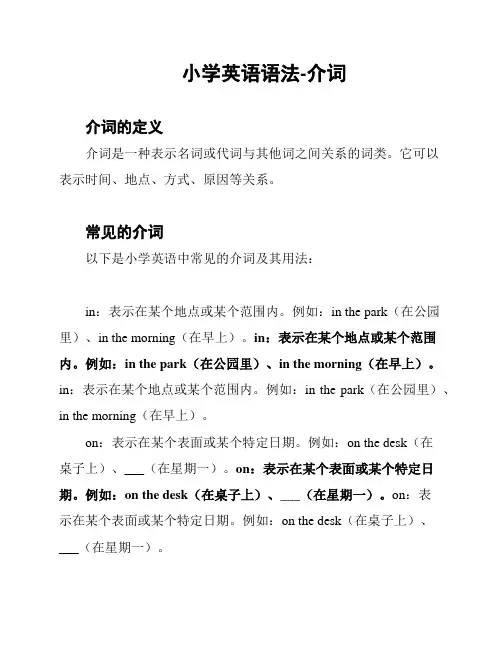
小学英语语法-介词介词的定义介词是一种表示名词或代词与其他词之间关系的词类。
它可以表示时间、地点、方式、原因等关系。
常见的介词以下是小学英语中常见的介词及其用法:in:表示在某个地点或某个范围内。
例如:in the park(在公园里)、in the morning(在早上)。
in:表示在某个地点或某个范围内。
例如:in the park(在公园里)、in the morning(在早上)。
in:表示在某个地点或某个范围内。
例如:in the park(在公园里)、in the morning(在早上)。
on:表示在某个表面或某个特定日期。
例如:on the desk(在桌子上)、___(在星期一)。
on:表示在某个表面或某个特定日期。
例如:on the desk(在桌子上)、___(在星期一)。
on:表示在某个表面或某个特定日期。
例如:on the desk(在桌子上)、___(在星期一)。
at:表示在具体的时间或某个地点。
例如:at 7 o'clock(在7点)、___(在学校)。
at:表示在具体的时间或某个地点。
例如:at 7 o'clock(在7点)、___(在学校)。
at:表示在具体的时间或某个地点。
例如:at 7 o'clock(在7点)、___(在学校)。
to:表示向某个地点或某个目标。
例如:go to the supermarket (去超市)。
to:表示向某个地点或某个目标。
例如:go to the supermarket(去超市)。
to:表示向某个地点或某个目标。
例如:go to the supermarket(去超市)。
from:表示从某个地点或某个时间开始。
例如:___(从星期一到星期五)。
from:表示从某个地点或某个时间开始。
例如:___(从星期一到星期五)。
from:表示从某个地点或某个时间开始。
例如:___(从星期一到星期五)。
by:表示通过某种方式或某个工具。
小学常用介词讲解及练习
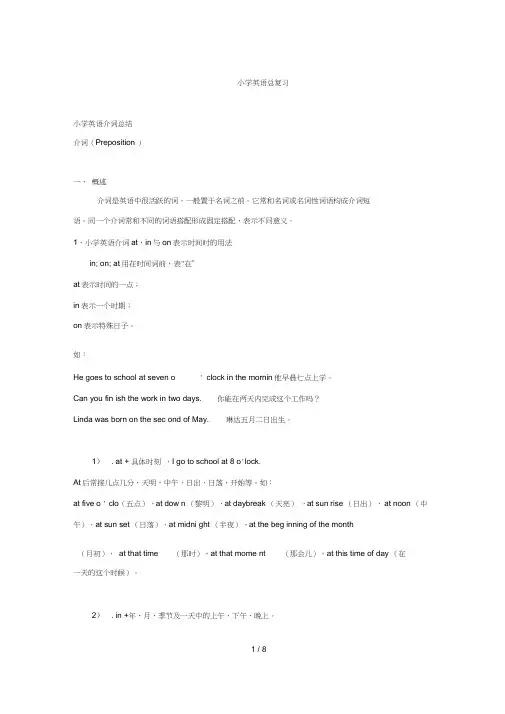
小学英语总复习小学英语介词总结介词(Preposition )一、概述介词是英语中很活跃的词,一般置于名词之前。
它常和名词或名词性词语构成介词短语。
同一个介词常和不同的词语搭配形成固定搭配,表示不同意义。
1、小学英语介词at,in与on表示时间时的用法in; on; at用在时间词前,表"在”at表示时间的一点;in表示一个时期;on表示特殊日子。
如:He goes to school at seven o ' clock in the mornin他早晨七点上学。
Can you fin ish the work in two days. 你能在两天内完成这个工作吗?Linda was born on the sec ond of May. 琳达五月二日出生。
1). at + 具体时刻,I go to school at 8 o'lock.At后常接几点几分,天明,中午,日出,日落,开始等。
如:at five o ' clo(五点),at dow n (黎明),at daybreak (天亮),at sun rise (日出),at noon (中午),at sun set (日落),at midni ght (半夜),at the beg inning of the month(月初),at that time (那时),at that mome nt (那会儿),at this time of day (在一天的这个时候)。
2). in +年、月、季节及一天中的上午、下午、晚上。
in 2006 (2006 年),in May , 2004 (2004 年五月),in the morning (早晨/上午),inthe after noon (下午),in the evening (晚上),in the ni ght (夜晚),in the daytime(白天),in the 21st century (21 世纪),in three days (weeks/month )三天(周/个月),in a week (一周),in spri ng (春季)。
小学英语语法专项讲解:介词
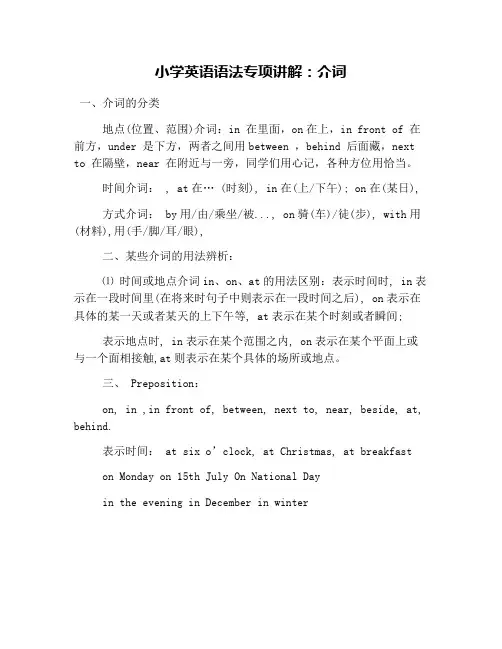
小学英语语法专项讲解:介词
一、介词的分类
地点(位置、范围)介词:in 在里面,on在上,in front of 在前方,under 是下方,两者之间用between ,behind 后面藏,next to 在隔壁,near 在附近与一旁,同学们用心记,各种方位用恰当。
时间介词: , at在… (时刻), in在(上/下午); on在(某日),
方式介词: by用/由/乘坐/被..., on骑(车)/徒(步), with用(材料),用(手/脚/耳/眼),
二、某些介词的用法辨析:
⑴ 时间或地点介词in、on、at的用法区别:表示时间时, in表示在一段时间里(在将来时句子中则表示在一段时间之后), on表示在具体的某一天或者某天的上下午等, at表示在某个时刻或者瞬间;
表示地点时, in表示在某个范围之内, on表示在某个平面上或与一个面相接触,at则表示在某个具体的场所或地点。
三、 Preposition:
on, in ,in front of, between, next to, near, beside, at, behind.
表示时间:at six o’clock, at Christmas, at breakfast
on Monday on 15th July On National Day
in the evening in December in winter。
(完整版)小学英语常用介词及用法
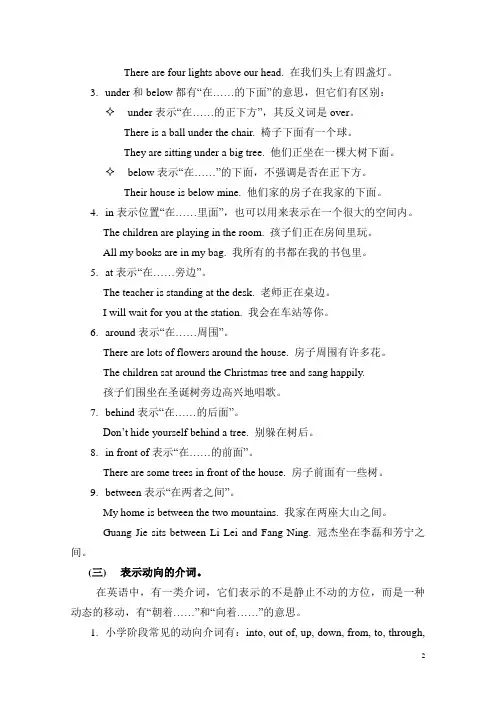
常见介词及用法(一)表示时间的介词1.英语里最常见的时间介词有:at, in, on, before, after和from。
2.at , in和on这三个词都表示时间。
✧at主要指具体的钟点:at half past eight 在八点半✧in一般指某一段时间:in January 在一月份✧on指具体在某一天:on Monday 在星期一3.before和after表示时间的先后顺序。
✧before表示“在……之前”。
You should wash your hands before eating. 吃饭前你应该洗手。
✧after表示“在……之后”。
They often play basketball after dinner. 他们放学后经常打篮球。
4.from作时间介词含有“从……开始”的意思,常和to连用,组成“from…to…”的结构,表示“从……到……”的意思。
We go to school from Monday to Friday. 我们从周一到周五上学。
(二)表示方位的介词,也就是表示位置和地点的介词。
1.小学阶段常见的方位介词有:on, in, at, under, over, above, below, about,around, between等。
2.on, over和above这三个词都有“在……上面”的意思,但它们所表示的方位还是有些不同。
✧on表示两个物体的表面相互接触。
如:There is a book on the desk. 桌上有一本书。
The boy is sleeping on the desk. 那个孩子睡在地上。
✧over表示“在……的正上方”,两个物体表面没有接触。
如:There is a light bulb over my head. 在我头顶上有一个灯泡。
✧above表示两个物体中一个在另一个的上方,如:The plane is flying above the clouds. 飞机上云层上飞行。
小学英语常用介词用法详解及练习
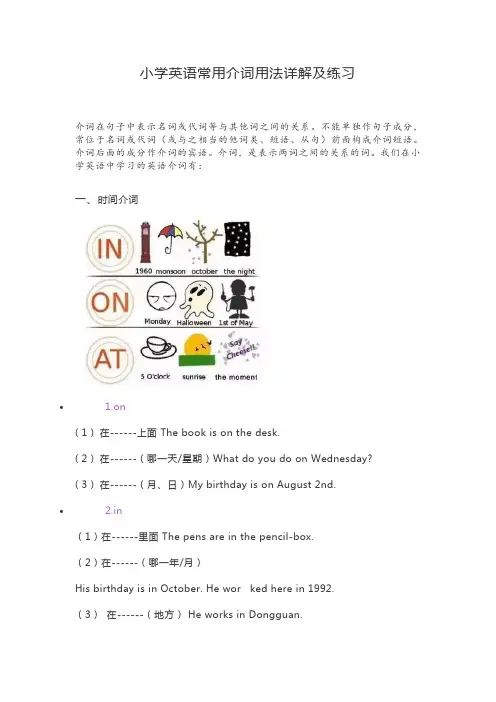
小学英语常用介词用法详解及练习介词在句子中表示名词或代词等与其他词之间的关系。
不能单独作句子成分,常位于名词或代词(或与之相当的他词类、短语、从句)前面构成介词短语。
介词后面的成分作介词的宾语。
介词,是表示两词之间的关系的词。
我们在小学英语中学习的英语介词有:一、时间介词• 1.on( 1 ) 在------上面 The book is on the desk.( 2 ) 在------(哪一天/星期)What do you do on Wednesday?( 3 ) 在------(月、日)My birthday is on August 2nd.• 2.in(1)在------里面 The pens are in the pencil-box.(2)在------(哪一年/月)His birthday is in October. He wor ked here in 1992.(3)在------(地方) He works in Dongguan.•(4)在------之内 What are you going to do in 20 years?•(5)在------(早上、下午、晚上)I do morning exercises in the morning every day.I usually play basketball in the afternoon.I often do my homework in the evening.• 3.at(1)在------(点钟)I usually go to school at 8:00 am.(2)在中午 at noon二、方位介词• 1. under 在------底下 There is a ball under the bed.• 2. near 在------附近 There is a book shop near ourschool.• 3. in front of在------前面A boy is standing in front of the house.• 4. beside 在------旁边 A football is beside thedoor.• 5. next to 紧挨着 There is a bus station next to No. 13 Middle School.• 6. over 在------正上方 A bridge is over the river.•7. on the left在------左边 The bookstore is on the left.•8. on the right在------右边The hospital is on the right.•9. before在……之前 Mike sits before me.•10. after在------以后 He went home after school.•11. in the middle在------中间The road is in the middle.•12. at(1)在------(小地方) I am at school today.I was at home yesterday.(2)看一看 Look at the blackboard.•13. behind 在------后面There is a broom behind the door.。
小学英语语法介词to和of与for的用法及练习含答案
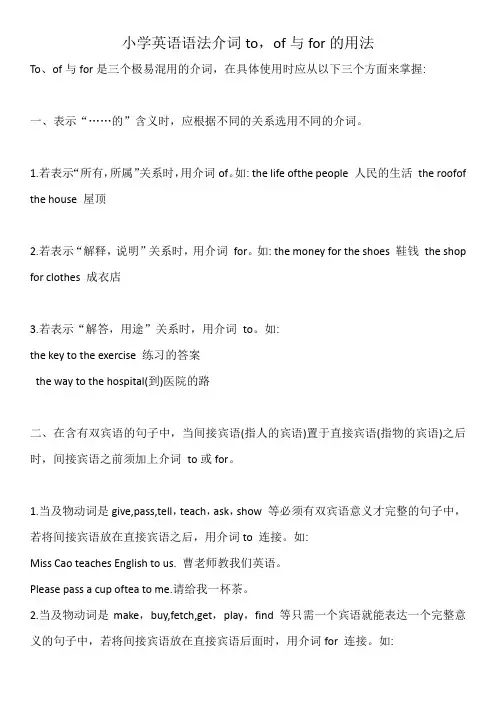
小学英语语法介词to,of与for的用法To、of与for是三个极易混用的介词,在具体使用时应从以下三个方面来掌握:一、表示“……的”含义时,应根据不同的关系选用不同的介词。
1.若表示“所有,所属”关系时,用介词of。
如: the life ofthe people 人民的生活the roofof the house 屋顶2.若表示“解释,说明”关系时,用介词for。
如: the money for the shoes 鞋钱the shop for clothes 成衣店3.若表示“解答,用途”关系时,用介词to。
如:the key to the exercise 练习的答案the way to the hospital(到)医院的路二、在含有双宾语的句子中,当间接宾语(指人的宾语)置于直接宾语(指物的宾语)之后时,间接宾语之前须加上介词to或for。
1.当及物动词是give,pass,tell,teach,ask,show 等必须有双宾语意义才完整的句子中,若将间接宾语放在直接宾语之后,用介词to 连接。
如:Miss Cao teaches English to us. 曹老师教我们英语。
Please pass a cup oftea to me.请给我一杯茶。
2.当及物动词是make,buy,fetch,get,play,find 等只需一个宾语就能表达一个完整意义的句子中,若将间接宾语放在直接宾语后面时,用介词for 连接。
如:Her uncle bought a new bike for her.她叔叔给她买了一辆新自行车。
Mother cooks breakfast for us every day.妈妈每天为我们做早饭三、当不定式短语作主语,谓语是系表结构(即“It+be+形容词+不定式”句型)时,若不定式动词需要逻辑主语时,其引导词可以是of也可以是for。
二者的选择主要取决于该句型中的形容词。
小学英语方位介词(含练习题)
小学英语方位介词1.on介词on表示“在某物之上”的意思,它通常表示一个物体在另一个物体之表面上面。
两者之间有接触。
•Your book is on the desk.你的书在课桌上面。
•There is a ball on the floor. 地板上有个球。
拓展:above 和over的区别on指的有接触面的上面,但是over和above都是没有接触面的上面。
over“在……正上方”,与under相对。
•There is a bridge over the river. 河上有一座桥。
•The picture is hanging over the blackboard. 那张图挂在黑板的正上方。
above只表示“在……上方或位置高出……”,不一定是正上方,与below相对。
• A plane flew above our heads. 一架飞机从我们头上飞过。
•The Turners live above us. 特纳一家人住在我们的上面。
2.in介词in表示“在某物的里面”,它通常表示一个物体在另外一个物体的内部、中间或者在某个范围之内。
•Your pen is in the pencil case. 你的钢笔在铅笔盒里面。
•She is the tallest in her class. 她是她们班最高的。
3.under介词under表示“在某物的下面”,它通常表示一个物体在另外一个物体的垂直正下面,两者之间没有接触。
•My bike is under the tree.我的自行车在树的下面。
•The shoes are under the chair. 鞋在椅子的下面。
拓展:under和below 的区别under表示“在……之下”,通常表示位置处于正下方,与介词over“在……上方”相对应。
•There is a book under the table.桌子下面有一本书。
• A cat is sitting under the table.一只猫在桌子下面。
小学英语介词的用法及专项练习
小学英语介词的用法及专项练习介词的定义和作用介词是英语中一类重要的词性,用于连接名词、代词、动词或者其他介词与其他成分之间的关系。
介词可以表达方向、位置、原因、时间等等。
常见的英语介词有:in, on, at, for, with, by, from, to, over, under 等。
介词的用法1. 表示地点表示地点- in: 在某个区域或范围内- The cat is in the box.(猫在盒子里。
)- on: 在某个平面或表面上- The book is on the table.(书在桌子上。
)- at: 在某个具体的位置- She is waiting at the bus stop.(她在公交车站等待。
)2. 表示时间表示时间- at: 表示具体的时间点- The meeting starts at 9 o'clock.(会议在9点开始。
)- on: 表示某一天或日期- I have an appointment on Monday.(我在星期一有个约会。
)- in: 表示一段时间内- They will go on vacation in July.(他们将在七月份去度假。
)3. 表示原因表示原因- for: 表示目的或理由- We go to the park for a picnic.(我们去公园野餐。
)4. 表示方式表示方式- with: 表示伴随或使用- She writes with a pen.(她用钢笔写字。
)5. 表示运动表示运动- from...to: 表示由某个地方到另一个地方- He walked from home to the school.(他从家里走到学校。
)介词练请根据句子的意思,选择适当的介词填空。
1. The dog is __ the yard.(狗在院子里。
)2. My birthday is __ Sunday.(我的生日在星期天。
小学人教版英语方位介词学习
小学英语方位介词1、in:在......里面(内部)例:She is in the classroom. 她在教室里。
2、on:在。
上面(表面上)例:There is a picture on the wall. 墙上有一幅画。
3、under:在。
下面。
与它相反的是over(在......上方)。
例:There is a little dog under the tree. 树下有一只小狗。
4、behind:在。
后面例:Is there a student behind the door?门后有一个学生吗?5、between:在。
中间。
(表达在两者中间,后面的名词要用复数形式)例:There is a small house between the hills. 在两座山中间有一个小房子。
6、beside:在。
旁边,相当于next to和by。
near意为“在。
附近”。
例:Don't sit beside me. = Don't sit by me. = Don't sit next to me. 不要坐在我旁边。
7、in front of:在。
前面(不包含)例:There is a tall boy in front of me.在我前面有一个个子高高的男孩。
8、in the front of:在。
前面(包含关系)例1:The blackboard is in the front of the classroom.黑板在教室的前面。
(黑板在教室内部,是包含关系)例2:There is a beautiful garden in front of the kitchen.有一个漂亮的花园在厨房的前面。
(花园和厨房是互不包含的,不加the)9、on the left:在左边;on the right:在右边;in the middle of:在。
中间例1:There is a book on your left.在你左边有一本书。
小学六年级英语介词知识点及练习题
【导语】学习英语可以让我们更好地认识汉语。
这句话听上去似乎有点⽭盾,但学习⼀门外语确实能够增加我们对母语的理解。
这是因此在学习外语的过程中我们会不断将其与母语⽐较,从⽽能够以⼀个新的⾓度来审视⾃⼰的母语。
以下是整理的《⼩学六年级英语介词知识点及练习题》相关资料,希望帮助到您。
【篇⼀】⼩学六年级英语介词知识点 ①in+⽉、年 the morning/afternoon/evening/a week 表⽰时间 ②on+具体某⼀天(⼏⽉⼏⽇)/某个假期(…Day) ③at+具体某点时间、某个假期(…Festival)/the weekend ①in…street 表⽰⽅位 ②on…road/left/right ③at the…crossing/stop/某个具体的地点 ①in the tree(不是树上长出来的) ②on the tree(树上原来⾃⼰长出来的) 表⽰时间: ① ago(……以前) later(……以后) ② before (在……以前) after(在 ……以后) be 动词和助动词 1、 be 动词(am/is/are) 主语 be 动词(原形) be 动词(过去式) I am was He/she/it is was We/you/they are were 2、助动词(do/does/did) Do+⾮第三⼈称单数 +动词原形…? …do/don't Does+第三⼈称单数 …does/doesn't Did+所有主格 …did/didn't What do you/they/we… +动词原形? I/They/We+动词原形… What does he/she/it… He/She/It +(动词+S)…. What did you/they/we/ he/she/it… I/They/We/ He/She/It +动词过去式。
【篇⼆】⼩学六年级英语介词练习题1 ( ) 1. Why did you get up so early ___ this morning.A. onB. /C. atD. in ( ) 2. He went to Shanghai___ September 3, 1991 and came back___ a cold morning last year.A. in; onB. on; inC. on; onD. in; ia ( ) 3. Lucy was born____ the night of May 12, 1984.A. onB. inC. atD. to ( ) 4. Mrs Brown came to China ____ 1996.A.onB. ofC. toD. in ( ) 5 ___ the morning of November 20, 1915, the workers came to Chicago to show their mourning of Joe Hill.A. OnB. InC. OnD. At ( ) 6. Ann moved___Hangzhou___September, 1992.A. /; inB. to; inC. to; on D, in; in ( ) 7. They started off___an autumn afternoon.A. duringB. atC. inD. on ( ) 8. He often goes ____ school ____ six thirty ____ the morning.A. for; to; inB. to; at; inC. to; for; at D, for; at; to ( ) 9. He arrived ___ Shanghai ___ 9: 30 ___ March 5.A. at; in; atB. to; on; atC. in; on; atD. in; at; on ( ) 10.The English teacher told me to get there____ half past ten.A. inB. atC. onD. of 参考答案: B C A D B A D B D B【篇三】⼩学六年级英语介词练习题2 ( ) 1. Children get gifts ____ Christmas and ____ their birthdays.A. on; onB. at; onC. in; inD. in; on ( ) 2.----There is nothing ____tomorrow afternoon, is there? -----No. We can have a game of table tennis.A. onB. inC. outD. up ( ) 3. A lot of students in our school were born____March, 1981.A. inB. atC. onD. since ( ) 4. He suddenly returned____ a rainy night.A. onB. atC. inD. during ( ) 5. My grandfather was born____Oct. 10, 1935.A. onB. inC. atD. of ( ) 6. The train is starting___five minutes.A. inB. atC. forD.still ( ) 7. Mike does his exercises ____ seven _____ the evening.A. on; toB. at; inC. by; ofD. at; on ( ) 8. Children wake up very early____the morning of Christmas Day.A. inB. onC. forD. at ( ) 9 ____ a cold winter morning, I met her in the stfeet.A. InB. OnC. AtD. For ( ) 10 It happened to be very cold____ the morning of our sports meeting.A. atB. onC. withD. of 参考答案:B A A A A A B B B B。
- 1、下载文档前请自行甄别文档内容的完整性,平台不提供额外的编辑、内容补充、找答案等附加服务。
- 2、"仅部分预览"的文档,不可在线预览部分如存在完整性等问题,可反馈申请退款(可完整预览的文档不适用该条件!)。
- 3、如文档侵犯您的权益,请联系客服反馈,我们会尽快为您处理(人工客服工作时间:9:00-18:30)。
小学英语介词讲解及练习小学英语总复习小学英语介词总结介词(Preposition)一、概述介词是英语中很活跃的词,一般置于名词之前。
它常和名词或名词性词语构成介词短语。
同一个介词常和不同的词语搭配形成固定搭配,表示不同意义。
二、常用介词的基本用法at①表示时间:I go to school at seven every day 我每天早上7点去上学。
②表示在某一具体地点:He is standing at the bus stop 他站在公共汽车站。
③表示动作的方向、目标:Let me have a look at the picture 让我看看这幅图。
④用于某些固定搭配:at once 立刻、马上at last 最后at the same time 同时at first 开始时not at all 一点也不about①表示大约时间:I's about six o'clock now. 现在大约6点钟了。
②表示地点;在……周围:Everthing about me is so beautiful 我周围的一切都那么美好。
③关于,对于:We are talking about the news. 我们正在谈论新闻。
after①在……之后:After dinner I watch TV. 晚饭后我看电视。
②在……后面:He came into the room after me. 他在我后面进了房间。
behind①在……之后:There is a bike behind the tree. 树后有一辆自行车②比……晚,迟于:The train is behind time. 火车晚点了by①在……旁:He is sitting by the bed. 他正坐在床边。
②到……时候:We have learned three English songs by now. 到现在为止,我们已经学会了三首英文歌曲。
③以……方式:I go to school by bus. 我乘公共汽车去上学。
④用于某些固定搭配:one by one 一个接一个by the way 顺便说一句for①为,给,替:I'll make a card for my teacher. 我要给老师做张卡片。
②由于:Thank you for helping me. 谢谢你帮我。
③表示给(某人)用的:There is letter for you. 这儿有你一封信。
in①在……里面:The pencil is in the desk. 铅笔在课桌里。
②在一段时间里:We have four classes in the morning. 我们上午有四节课。
③用,以:What's this in English? 这用英语怎么说?④在某一年份,季节,月份:in 2002, in spring, in January⑤表示状态,服饰:Helen is in yellow. 海伦身穿黄色衣服。
⑥在……方面:He is weak in English. 他的英语不行。
⑦用于某些固定搭配:in front of 在……前面in the end 最后in time 及时like①像……样:He looks like his father. 他像他的父亲。
②这样,那样:Don't look at me like that. 别那样看着我。
③怎样:What's the weather like? 天气怎样。
near靠近,在……附近:My bed is near the window. 我的床在窗户旁。
of①的(表示所属关系):This is a photo of my family. 这是一张我家的照片。
②……的(用于所有格):He is a friend of mine. 他是我的一个朋友。
③表示数量(与连词连用):One of us is from Beijing. 我们中有一个来自北京④想到,谈到:I often think of them. 我常常想到他们。
⑤用于某些固定搭配:of course 当然because of 因为,由于on①在……上面:There are some apple on the tree. 树上有些苹果。
②在(星期)天,在某天的上午(下午,晚上):They go to English class on Sunday. 星期天他们去上英语课。
I left Beijing on the morning of May 1. 我在5月1日早上离开北京。
③用于某些固定搭配:on duty 值日on time 准时over①在……正上方:There is a lamp over the table. 桌子上方有一盏灯。
②遍及,穿过:There is a bridge over the river. 有座桥横跨那条河。
③超过,不止:She is a little over 2. 她两岁多了。
to①到,往,向:He walks to the window. 他走向窗户。
②表示时间、数量,到……为止Please count from ten to thirty. 请从10数到30.③向,对,给:Happy New Year to you all. 大家新年好。
underWhat's under your desk? 你书桌底下是什么?with①和,写:Could you go home with me? 你能和我一起回家吗?②表示伴随状态,带有:Who's that girl with glasses? 那位戴眼睛的女孩是谁?三、介词的固定搭配1)介词和名词的连用2)动词和介词的连用at arrive at/in 到达at first 起初;开始get off 下车at last 最后help sb. With sth. 帮组某人做某事at school 在上课,在上学ask for 请求at the moment 此刻get up 起床at home 在家;无拘束laugh at 嘲笑at present 现在learn from 向……学习at work 上班,在工作look after 照顾at the same time 同时look for 寻找think for 想到on worry about 担心on duty 值日listen to 听on holiday 度假look at 看;注视on time 准时talk about 交谈;谈on the left/right 在左/右边wait for 等候;等on the radio 在广播中thank for 为……而感谢on foot 步行on sale 出售;降价出售3)形容词和介词连用on TV 在电视上播放be afraid of 害怕on the phone 在电话中be careful with 小心;关心on the way 在路上be interested in 对……感兴趣be good at 善于in be proud of 感到自豪in all 总体be crazy about 酷爱in class 在课堂上be late for 干某事迟到in English 用英语be good for 对……有利in short 总之4)其他in a hurry 匆忙地by+交通工具in the end 最后by bus/train/plane/air/ship/bike/sea/land…in bed 躺在床上lots of/a lot of 许多,大量in danger 在危险中at most 至多in fact 事实上at least 至少in time 及时地at once 立刻;马上in a minute 立刻in order to 为了、小学英语介词at,in与on在时间方面的用法at表示时间的一点;in表示一个时期;on表示特殊日子。
如:He goes to school at seven o’clock in the morning. 他早晨七点上学。
Can you finish the work in two days. 你能在两天内完成这个工作吗?Linda was born on the second of May. 琳达五月二日出生。
1>. at后常接几点几分,天明,中午,日出,日落,开始等。
如:at five o’clock (五点),at down (黎明),at daybreak (天亮),at sunrise (日出),at noon (中午),at sunset (日落),at midnight (半夜),at the beginning of the month (月初),at that time (那时),at that moment (那会儿),at this time of day (在一天的这个时候)。
2>. in后常接年,月,日期,上午,下午,晚上,白天,季节,世纪等。
如:in 2006(2006年),in May,2004 (2004年五月),in the morning (早晨/上午),in the afternoon (下午),in the evening (晚上),in the night (夜晚),in the daytime (白天),in the 21st century (21世纪),in three days (weeks/month)三天(周/个月),in a week (一周),in spring (春季)。
3>. on后常接某日,星期几,某日或某周日的朝夕,节日等。
如:on Sunday (星期日),on a warm morning in April (四月的一个温暖的上午),on a December night (12月的一个夜晚),on that afternoon (那天下午),on the following night (下一个晚上),on Christmas afternoon (圣诞节下午),on October 1,1949 (1949年10月1日),on New Year’s Day (新年),on New Yea r’s Eve (除夕),on the morning of the 15th (15日的早上)等。
常用的方位介词有:in on to在范围之内用in在范围之外,如果两地接壤就用on 不接壤的用toBeijing is in the north of China .Japan is to the east of China .Shanxi Province is on the west of Hebei Province .1. at表示"在......处",一般指较小的比较具体的地点。
